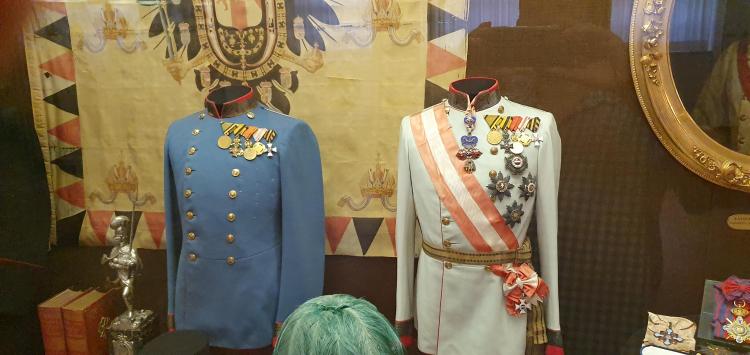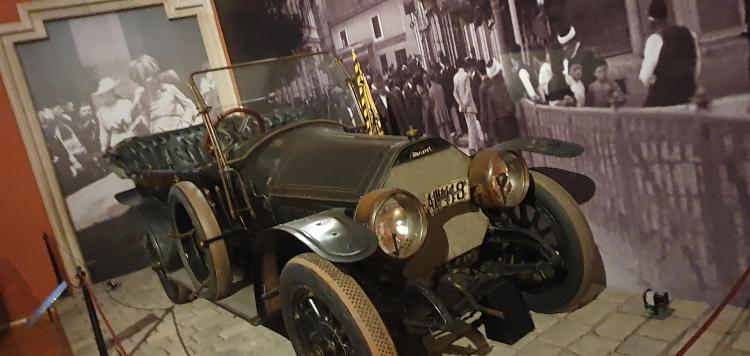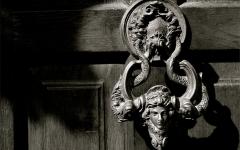OF BLOOD AND GLORY: VIENNA’S MUSEUM OF MILITARY HISTORY, THE HEERESGESCHICHTLICHES MUSEUM
by Imre Bártfai
The museum features a tremendous amount of historical artifacts, related to the history of warfare. The 19th century building was opened up to the public in 1869. Among the ones of defined the museum’s purpose was Crown Prince Rudolf of Austria, who emphasized the importance to present Austria’s military glory in full splendor. Talking about glory and splendor, there is a lot of them in this majestic building, before which, a gigantic Austrian soldiers sculpture stands guard, a sad memento of war. Inside the entry hall there is the Feldherrenhalle, a room with 56 marble figures, all of them famous generals in Austrian service. (Though not all Austrians, of course, we were happy to catch the sight of our beloved general Count Nicholas Zrínyi, a Hungarian, among the figures, and that of Adolf Schwarzenberg who liberated my city from the Ottomans in 1594.) Some of the famous generals presented may not mean the same to all spectators, as our guide, Herr Litscher emphatically remarked, when he pointed to the statutes of generals, whose main service to Austria was crushing national rebellions in 1848-49, the time of revolutions.
Heading up on the staircase, which looks royal because of the red carpet, we see the bust of Emperor Franz Joseph, and the hall of glory. That hall is a celebration of military glory, and frankly, it has quite a presence. You can look at the frescoes depicting Austria’s greatest victories, from the battle of Nördlingen, (1634) through the late 19th century, when victories became less frequent and sacrifice more prevalent. Wall plaques list the names of 500 army officers, along with coats of arms, belonging to the territories of Austro-Hungarian Empire. (Photo: Imre Bártfai © Heeresgeschichtliches Museum)

The Museum seems to be mainly for the presentation of Austrian imperial history. It does not have a medieval collection, and the richest material presented belongs to the period between 1500 and 1918. (Although the collection features material up to 1955 and some of the post-World war 2 pieces are very interesting as well.)
The building has eight halls: Hall I is to present the military history of the time between 1600-1700, Hall 2 shows (1701-1789), Hall III the revolutions (1789-1849), Hall IV Radetzky and his era (1848–1866), Hall V Franz Joseph and Sarajevo, (1867-1914) Hall VI the World War I, and Hall VII Republic and Dictatorship (1918–1945) so this one was dedicated to the post-imperial Austria. The last hall, Hall VIII shows Austria as a naval power.
Not only loads and loads of guns, armors, swords, medals, flags and uniforms, but satisfying the true enthusiast and the specialist -some truly unique pieces of history. Some of these are unlikely to appear in other museums, like a Turkish state tent from the late 17th century, (truly a breathtaking spectacle, to which the museum dedicated a corner) a Jacobin cap, or the weapons and armor of famous historical personalities. Other special items include a French Napoleonic war balloon from 1796, used to monitor troop movements in the revolutionary wars. Similar pieces of interest are the armors of General Laudon, and the famous Prince Eugen of Savoy, (along with his sword) the throne of Russian Empress Elisabeth, and captured Prussian flags from the Silesian wars.
Two other cabinets captured my attention especially, one featured the memorabilia of Emperor Maximilian’s failed adventure in Mexico (truly a curiosity), and some of World War I uniforms worn by Austria’s enemies: you can find almost everything in the museum, weapons and uniforms from Gallipoli, the Russian front, or early 20th century Bosnia, where the imperial troops suppressed a rebellion. Also, more mechanically minded people can find things for their own attention too, such as a World War I fighter aircraft (the Phönix 20.01 prototype) suspended from the roof, or a gigantic howitzer, (a Skoda M1916 38cm) used to shell beleaguered fortifications in World War I. (Photos: Imre Bártfai © Heeresgeschichtliches Museum)



Among the loads of military stuff, the most striking is the room dedicated to the Sarajevo assassination. Seeing the car of Franz Ferdinand himself, and his blood-covered uniform, which was cut up to free the flesh for the doctor’s operations (although too late and without much chance to save his life) makes you wondering. It is history itself before our eyes, one could say, our world was born that day in the early summer of 1914, and witnessing the bullet marks on the ominous car, makes one wonder about the inevitability of fate and history. What if he had survived?
If you want to see everything the museum has to offer you’ll likely need 3-4 hours. Taking pictures is free, but the pictures taken will be the property of the museum, so please note, you should not to use them for publications without their approval. However, already the plethora of pictures gathered for your own collection may very well satisfy your inner history buff. (And in some museums taking pictures is not allowed or not free.) Only back in Budapest did we recognize that we failed to see everything, so, there must be a next visit…
The museum has a nice coffee and gift shop, offering some replicas of military equipment, model kits, tin soldiers, and many military themed Osprey books for the ones hungry for knowledge of military affairs, of blood and glory. And tragedy, of course.



